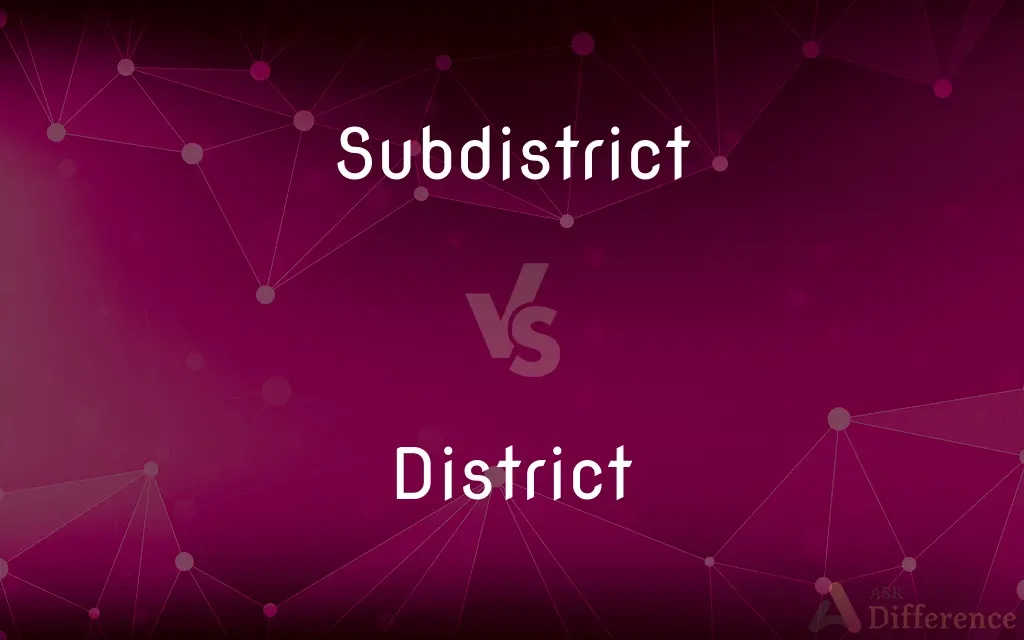Subdistrict vs. District — What's the Difference?
By Fiza Rafique & Urooj Arif — Updated on April 8, 2024
A subdistrict is a smaller administrative division within a district, focusing on local governance, while a district is a larger area with broader administrative powers and responsibilities.

Difference Between Subdistrict and District
Table of Contents
ADVERTISEMENT
Key Differences
Subdistricts are typically subdivisions of districts, designed to facilitate more localized governance and administrative convenience. They often focus on managing the day-to-day affairs of smaller communities within their boundaries. On the other hand, districts serve as significant administrative units that encompass multiple subdistricts, overseeing broader governance tasks such as education, healthcare, and infrastructure development across a wider area.
Subdistricts provide a more intimate understanding of local needs and issues, enabling tailored responses to community concerns. Whereas districts, with their larger scope, tend to formulate and implement policies that address the collective needs of all subdistricts under their jurisdiction, sometimes at the expense of localized specificity.
The administration of a subdistrict is usually headed by a local government official, such as a subdistrict head, who works closely with the community. In contrast, districts are often managed by higher-ranking officials like district commissioners or mayors, who oversee a more extensive administrative team and coordinate with subdistrict heads for effective governance.
Subdistricts allow for the efficient delivery of public services at a more localized level, potentially leading to quicker response times and more community-specific solutions. Meanwhile, districts have the resources and authority to undertake larger projects and initiatives that can benefit multiple subdistricts simultaneously, though these may be less tailored to individual community needs.
In terms of legal and fiscal matters, subdistricts usually have limited autonomy and rely on districts for a significant portion of their budget and legal authority. Districts, however, possess broader powers to levy taxes, allocate budgets, and enact regional laws that affect their entire area, including all subdistricts within it.
ADVERTISEMENT
Comparison Chart
Administrative Level
Lower, operates under district authority
Higher, oversees multiple subdistricts
Scope of Authority
Limited, focuses on local governance and community issues
Broad, includes regional planning, infrastructure, and services
Head of Administration
Typically a local official like a subdistrict head
Higher-ranking official like a district commissioner or mayor
Policy and Decision Making
More localized, focusing on immediate community needs
More comprehensive, with policies affecting a wider area
Financial Autonomy
Limited, relies on allocations from district budgets
Greater, with authority to levy taxes and allocate budgets across subdistricts
Compare with Definitions
Subdistrict
It serves as the first level of contact between the local government and the community.
The subdistrict office coordinated the disaster relief efforts efficiently.
District
They have the authority to enact laws and policies affecting a wide area.
The district council approved the construction of a new park.
Subdistrict
A subdistrict is a smaller administrative entity within a district.
The health department launched a vaccination drive in every subdistrict.
District
Districts are involved in regional planning, infrastructure development, and service delivery.
The district's new hospital will improve healthcare accessibility in the region.
Subdistrict
Subdistricts often encompass a number of villages or neighborhoods.
The new library will serve all the villages in the subdistrict.
District
It oversees the administration of multiple subdistricts within its territory.
The district commissioner held a meeting with all subdistrict heads to discuss the budget.
Subdistrict
They focus on local governance, public services, and community issues.
Residents approached the subdistrict head to address the water scarcity issue.
District
Districts manage larger projects and initiatives benefiting multiple communities.
The district's education department introduced a scholarship program for students in all subdistricts.
Subdistrict
Subdistricts facilitate tailored administrative responses to local needs.
The subdistrict implemented a unique recycling program tailored to its residents' habits.
District
A district is a significant administrative division with broad governance powers.
The district launched a new public transportation initiative.
Subdistrict
A subdistrict or sub-district is an administrative division that is generally smaller than a district.
District
A district is a type of administrative division that, in some countries, is managed by the local government. Across the world, areas known as "districts" vary greatly in size, spanning regions or counties, several municipalities, subdivisions of municipalities, school district, or political district.
Subdistrict
A district forming part of a larger district.
District
A division of an area, as for administrative purposes.
Subdistrict
(transitive) To divide (a district) into subdistricts.
District
A region or locality marked by a distinguishing feature
Went to the lake district for their vacation.
District
To mark off or divide into districts.
District
An administrative division of an area.
The Soho district of London
District
An area or region marked by some distinguishing feature.
The Lake District in Cumbria
District
(UK) An administrative division of a county without the status of a borough.
South Oxfordshire District Council
District
(transitive) To divide into administrative or other districts.
District
(obsolete) rigorous; stringent; harsh
District
Rigorous; stringent; harsh.
Punishing with the rod of district severity.
District
The territory within which the lord has the power of coercing and punishing.
District
A division of territory; a defined portion of a state, town, or city, etc., made for administrative, electoral, or other purposes; as, a congressional district, judicial district, land district, school district, etc.
To exercise exclusive legislation . . . over such district not exceeding ten miles square.
District
Any portion of territory of undefined extent; a region; a country; a tract.
These districts which between the tropics lie.
District
To divide into districts or limited portions of territory; as, legislatures district States for the choice of representatives.
District
A region marked off for administrative or other purposes
District
Regulate housing in; of certain areas of towns
Common Curiosities
How does a district differ from a subdistrict?
A district is a larger administrative division that oversees multiple subdistricts, with broader responsibilities including regional planning and infrastructure development.
Who heads the administration of a subdistrict?
The administration of a subdistrict is usually headed by a local government official, such as a subdistrict head.
What kind of responsibilities do districts have?
Districts are responsible for comprehensive governance tasks, including education, healthcare, infrastructure development, and policy implementation across their territory.
How do subdistricts benefit local communities?
Subdistricts provide localized governance, ensuring that community-specific needs and issues are addressed efficiently.
Can subdistricts make their own policies?
Subdistricts have limited autonomy and primarily focus on implementing district-level policies, with some discretion to address local needs.
What challenges do subdistricts face?
Subdistricts may face challenges related to limited autonomy, resources, and the need to meet diverse local demands within broader district policies.
What is a subdistrict?
A subdistrict is a smaller administrative unit within a district that focuses on local governance and community-specific issues.
Why are districts important in administrative governance?
Districts play a crucial role in administrative governance by coordinating policies and resources across multiple subdistricts to ensure regional development.
What is the role of a district commissioner?
A district commissioner is a high-ranking official who oversees the administration of a district, including all its subdistricts.
Can a subdistrict encompass multiple villages?
Yes, a subdistrict often encompasses multiple villages or neighborhoods, serving as a link between the local government and these communities.
Do subdistricts have legal authority?
Subdistricts have limited legal authority and depend on the district for broader legal powers and decision-making capabilities.
What is the main difference in the scope of authority between districts and subdistricts?
The main difference lies in the scope of authority; subdistricts focus on local issues, while districts have broader responsibilities affecting a wide area.
How are districts and subdistricts funded?
Subdistricts are typically funded through allocations from the district budget, whereas districts have broader powers to levy taxes and allocate budgets.
How do district-level decisions impact subdistricts?
District-level decisions impact subdistricts by setting overarching policies and resource allocations that guide subdistrict governance and service delivery.
How do districts and subdistricts work together?
Districts and subdistricts work together through coordinated policy implementation and resource allocation to serve the wider community's needs.
Share Your Discovery

Previous Comparison
Headphones vs. Cans
Next Comparison
Result vs. CauseAuthor Spotlight
Written by
Fiza RafiqueFiza Rafique is a skilled content writer at AskDifference.com, where she meticulously refines and enhances written pieces. Drawing from her vast editorial expertise, Fiza ensures clarity, accuracy, and precision in every article. Passionate about language, she continually seeks to elevate the quality of content for readers worldwide.
Co-written by
Urooj ArifUrooj is a skilled content writer at Ask Difference, known for her exceptional ability to simplify complex topics into engaging and informative content. With a passion for research and a flair for clear, concise writing, she consistently delivers articles that resonate with our diverse audience.














































